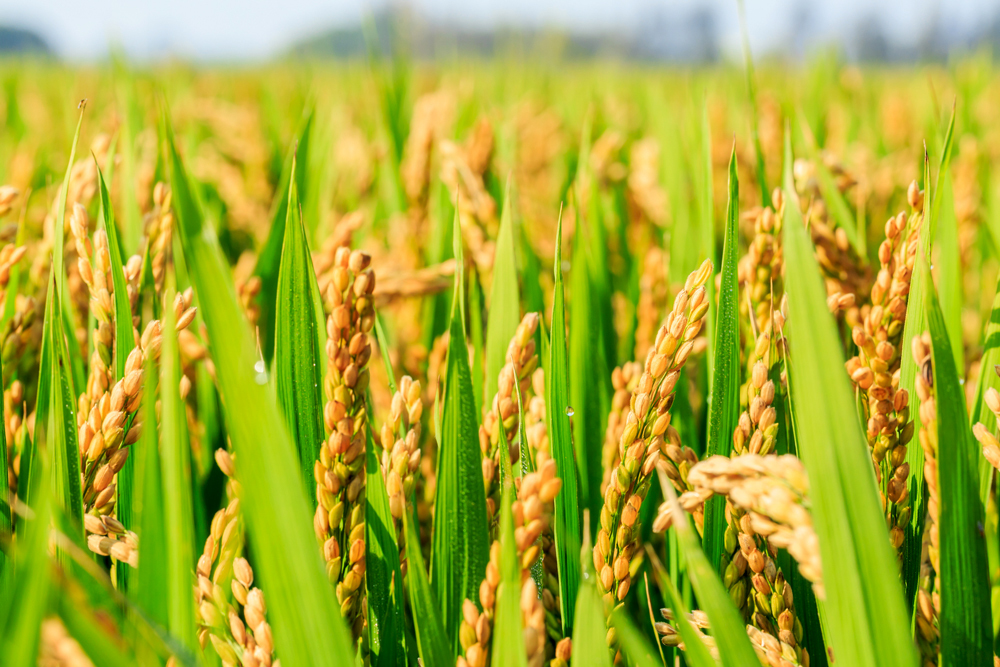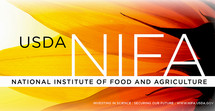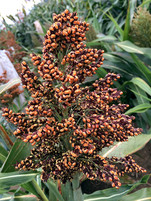| Having trouble viewing this email? View it as a Web page.  | | | Editor: Kelly Sprute June 23, 2021 Making a Difference  Field of ripe rice, courtesy of Getty Images. Rising Nighttime Temps Rob Yields in Rice, Wheat Warmer nights can upset a good night's sleep for humans, but could the biological processes of farm crops be fussy about nighttime temperatures, too? Researchers at Kansas State University (K-State) and North Carolina State University (NCSU) think so, and they've got a growing amount of evidence to prove that the circadian clock genes in rice, and possibly wheat, get messed up when nights get hotter. NCSU's Colleen Doherty and K-State's Krishna Jagadish began studying the impact of nighttime temperatures seven years ago. "Essentially, we found that warmer nights throw the rice plant's internal clock out of whack," Doherty said. Warm temperatures cause "hundreds of genes" to be expressed earlier than usual, and hundreds more to be expressed later than usual, disrupting key biological processes, Jagadish said. The researchers' goal is to better identify the factors that disrupt the plants' circadian rhythms so that scientists can breed varieties that perform better under conditions with higher nighttime temperatures. The research is supported by USDA's National Institute of Food and Agriculture. For more information, read the K-State news article. | |  NIFA Nutrition Security: An Overview of Current Activities and Aims Webinar Series Join NIFA for the first installment of the Nutrition Security Webinar Series tomorrow from 4 - 5 p.m. ET (3 - 4 p.m. CT). The series will feature a range of topics and diverse speakers focused on prioritizing nutrition security during and beyond the COVID-19 pandemic. The June 24 webinar will kick off the series with an introduction from NIFA Director Dr. Carrie Castille. Then, panelists from the NIFA Nutrition Team will share an overview of the agency's current and future contributions to help accelerate prioritizing nutrition security both during and after the pandemic. Members of the audience will be highly encouraged to participate in a live Q&A discussion. For more information, or to register in advance, go to NIFA's webinar announcement. After registering, you will receive a confirmation email containing information about joining the webinar. Food security graphic, courtesy of Getty Images. |  Agriculture Secretary Tom Vilsack Issues USDA Proclamation Recognizing National Pollinator Week Agriculture Secretary Tom Vilsack recently issued a USDA proclamation to recognize the week of June 21 – 27, 2021 as National Pollinator Week. Pollinator species, such as birds, bats, bees, and other insects, play an important role in producing more than 100 crops grown in the United States. Honey bee pollination alone adds more than $18 billion in value to agricultural crops annually and is critical to ensuring our diets are plentiful with fruits, nuts, and vegetables. "The health of these agricultural contributors is critical to the vitality and sustainability of U.S. agriculture, food security, and our nation's overall economy," said Secretary Vilsack. For more information, read the USDA press release. |  Open Period for Farm Bill Funding Opportunities Supporting Animal Disease Preparedness and Response Activities USDA's Animal and Plant Health Inspection Service (APHIS) is continuing its efforts as part of the agency's Farm Bill programs to advance animal disease preparedness and response. APHIS is seeking project proposals for fiscal year 2021 funding for the National Animal Disease Preparedness and Response Program and the National Animal Health Laboratory Network. For more information, read the APHIS press release. |  NIFA Career Opportunities We are hiring! Remember to check out NIFA's Career Opportunities webpage, where there is a direct link to all open positions. You can also explore NIFA jobs at the USAjobs.gov website. Current openings in Kansas City, Missouri: Congressional Affairs Officer (Stakeholder Affairs Officer) (GS-15)
Closing Date: 06/24/2021 Staff Accountant (GS 9-12)
Closing Date: 06/28/2021 Financial Policy Specialist (GS 9-12)
Closing Date: 06/28/2021 Lead Financial Specialist (GS-13)
Closing Date: 06/28/2021 Biological Science Specialist (National Program Leader) (GS 13-14)
Closing Date: 07/09/2021 Supervisory Biological Science Specialist (Division Director) (GS-15)
Closing Date: 07/15/2021 |  Experiences with Extension and Virginia State University Prepared Alumna for Key Post at USDA This wasn't the original path for Jewel Bronaugh. She didn't intend to become the Deputy Secretary of the United States Department of Agriculture and the first Black woman to hold the position. An educator by trade, Bronaugh instead wanted to follow in her parents' footsteps and become a teacher. She wanted to work with people and help them achieve success in the classroom. But instead of following their path – she forged her own. Now, she's not only helping youth achieve success, she's helping the entire country. On May 13, the former dean of the College of Agriculture at Virginia State University and 4-H youth development specialist was confirmed as the Deputy Secretary of the USDA after being nominated in January by then President-elect Joe Biden. For more information, read the Virginia Tech article. Deputy Secretary of Agriculture Jewel Bronaugh, courtesy of USDA. |  GHG Data Deep Dive Reaches New Level of 'Reasonable and True' For the most accurate accounting of a product's environmental impact, scientists perform a calculation known as a life cycle assessment, and greenhouse gas (GHG) emissions are a key component. For corn ethanol, most GHG emissions can be mapped to production, transportation, and combustion, but a large portion of them can be traced to the farm. However, due to privacy concerns, scientists can't access individual farm management decisions such as fertilizer type and rate. In a new study from University of Illinois and U.S. Department of Energy's Argonne National Laboratory, researchers developed county-level nitrogen application datasets for corn, dramatically improving the accuracy of GHG calculations for the crop. Funding was provided in part by USDA's National Institute of Food and Agriculture. For more information, read the University of Illinois ACES article. Yushu Xia holds a greenhouse gas sampling ring, courtesy of University of Illinois. |  Disease Resistance in Sorghum Germplasm Lines Gauged for Production on Pennsylvania Farms Sorghum is valuable for yielding human food, animal feed and biofuels. Drought resistant and needing a smaller amount of nutrients than corn to thrive, sorghum seems to be a crop that would do well in the Keystone State's climate in a warming world. But its susceptibility to fungal disease is problematic. With sorghum poised to become an important crop grown by Pennsylvania farmers, Penn State researchers, in a new study, tested more than 150 germplasm lines of the plant for resistance to a fungus likely to hamper its production. After evaluating tests, researchers noted that they discovered sources of resistance to anthracnose leaf blight. USDA's National Institute of Food and Agriculture and the Fundación Alfonso Martin Escudero for postdoctoral research provided funding for this work. For more information, read the Penn State news article. Sorghum, courtesy of Penn State University. |  Food Pantry Videos Food pantries have been shown to increase access and consumption of healthy foods, address food insecurity and provide a place for direct nutrition education. Professionals using policy, systems, and environmental (PSE) approaches increases access to healthy food and physical activity options for low-income individuals and families. This site is a starting point for you to learn how to engage specific settings with PSE approaches. The Regional Nutrition Education and Obesity Prevention Centers of Excellence initiative was created to strengthen the science and enhance dissemination of nutrition education and obesity prevention strategies, and interventions that produce measurable improvements in health, obesity, nutrition (food behavior), and physical activity-related outcomes of interest to USDA. This project all started in 2014 with a NIFA Agriculture and Food Research Initiative grant on Food Security and is still sustainable today. View the SNAP-Ed Integrative Map or watch the videos for more information. Box of healthy foods, courtesy of Getty Images. |  | | | NIFA's mission is to invest in and advance agricultural research, education, and extension that solve societal challenges. NIFA's investments in transformative science directly support the long-term prosperity and global preeminence of U.S. agriculture. Keep informed about NIFA, USDA, our land-grant and non-land-grant university partners, and stakeholders with the NIFA Update. Read past issues online, sign up for email updates or follow us on Twitter @USDA_NIFA, #NIFAImpacts or LinkedIn @usda-nifa. If you wish to submit a news item or information, send an email to NIFAUpdate. USDA is an equal opportunity lender, provider, and employer. | | | |

No comments:
Post a Comment